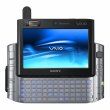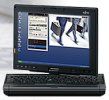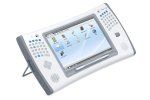Types of UMPC
Assuming you want to learn more about the features, advantages and limitations of a UMPC, lets go through the basic designs and then go deeper into specifications and details.
Device designs within the ultra mobile PC segment.
As we mentioned before, there are variations in devices within the ultra mobile PC segment. Every manufacturer is looking for their own spot in the marketplace and will be designing with certain target users in mind. Within the ultra mobile PC segment the devices currently range from low-powered Linux-based mini tablets, right up to high-powered keyboarded formats running Microsoft Windows Vista. The price bracket also ranges from under $400 to well over $2000 but in general, there are only two types of ultra mobile PC device. The ‘tablet’ format ultra mobile PC (without keyboard) and the ultra mobile PC (with a keyboard or thumbboard.) The two categories of device are shown below.
Tablet format UMPC’s (without Keyboard)
These devices generally use some form of touch or pen input to control the device. They may also support handwriting recognition and speech input. Many of the original “Origami’ UMPCs were in this category but in 2007 most devices are being produced with some form of keyboard input mechanism. This trend is expected to continue, especially for devices aimed at the consumer market. Tablet devices have the advantage that they are generally smaller and lighter. Its possible to connect a normal USB or Bluetooth keyboard so they do offer the flexibility and choice.
UMPCs with keyboards or thumbboards.
Finding greater popularity and responding to previous customer disappointment or misunderstanding are UMPCs with keyboards in various forms. This segment actually comprises two sub-segments. Devices with normal keyboards for a familiar desktop typing experience, and thumbboard layouts. The desktop format keyboards appear mostly in the larger screened UMPCs aimed at the business markets. Devices take either a notebook format or a convertible, swivel screen format where the device can be turned into a tablet. Thumbboards are being experimented with in many differing formats. From hidden keyboards to split-format keyboards. Many more variants on this them are sure to appear. In general, the convertible designs are aimed towards the higher end of the market. A keyboard is an important element of the ultra mobile PC and should be considered carefully. Read reviews and look at statistics (some stats on the relative speeds of keyboards here) but ultimately, try and get hands on.
For most people, the keyboard (or lack of it) will be the first decision to be made and the answer will depend on how you intend to use your UMPC. (Sofa, Car, Bed, Office, Train, Plane, Coffee Shop, Customer premises) and how much you intend to input into the device. (will you use natural handwriting for brief but ultra lightweight operation or will you need a full keyboard for reports, emails or blogging. Thumbboards will naturally appeal to the younger customer but must not be ignored as a quick input method that, in two-handed operation can be a good balance between input speed and input volume. Here’s a good demonstration of a blog being made using a fabric keyboard.
When making your form factor choice for the first time, don’t underestimate the amount of time you might use the device in a social setting. Once you feel comfortable using a device on the sofa, bed, bus or coffee shop you might be surprised at how often you find yourself using the ultra mobile PC in these settings!



















I am looking for a UMPC with a dial up modem or PCMCIA slot. Can you help me? Thanks.
Mistake on page 4: “The recommendation today is that XP is generally better than XP on currently available hardware due to the maturity of the driver software.”
Great article.